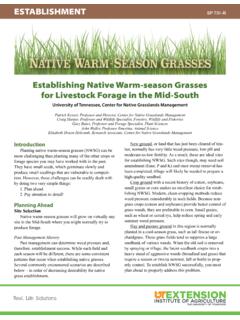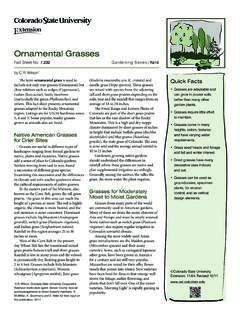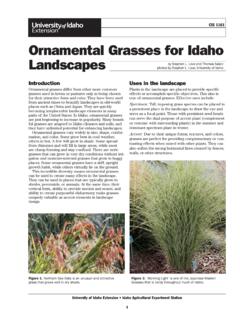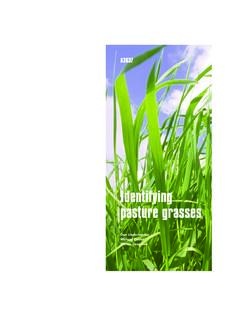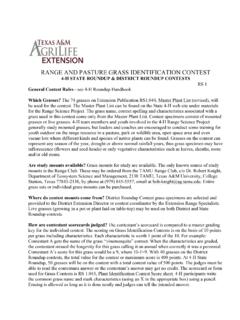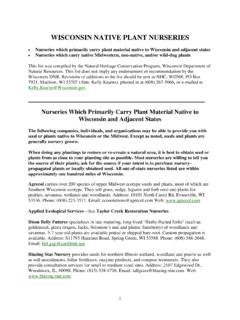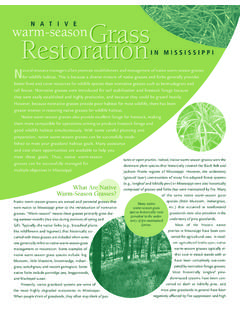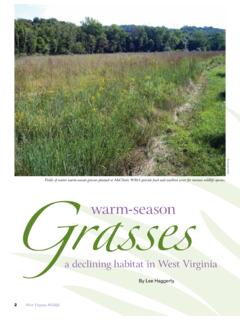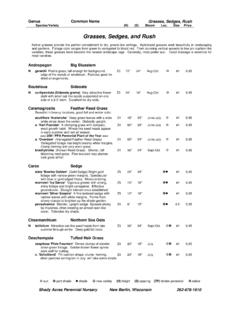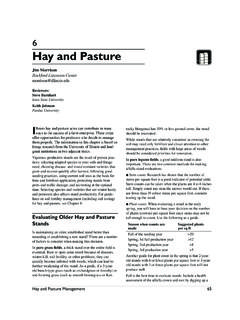Transcription of Using Prescribed Fire to Manage Native Grass Forages in ...
1 1 Patrick Keyser, Professor and Director, Center for Native Grasslands ManagementCraig Harper, Professor and Wildlife Specialist, Forestry Wildlife, and FisheriesGary Bates, Professor and Forage Specialist, Plant SciencesRay Smith, Professor and Forage Specialist, Plant and Soil Sciences, University of KentuckyTom Keene, Hay Specialist, Plant and Soil Sciences, University of KentuckyChris Lituma, Research Associate, Center for Native Grasslands ManagementUniversity of Tennessee, Center for Native Grasslands ManagementUsing Prescribed fire to Manage Native Grass Forages in the Mid-SouthFIRESP 731-J (Available online only)Introduction Throughout North America and the world grasslands have been maintained by fire for millennia. fire and drought held back the encroachment of trees and kept grasslands from becoming closed canopy forests (Fig.)
2 1). fire is effective at maintaining grasslands because grasses are fire adapted ; that is, they respond well to fire rapid re-growth, improved seed germination, even providing their own fuel (in the form of litter) to carry fires. One reason switchgrass, for instance, has been identified as a prospective fuel source is the amount of energy present within its leaves and stems. If you have ever burned a stand of switchgrass, then surely you appreciate just how intense a fire it produces. The image of a prairie fire in the Great Plains in the early days of settlement is well known, and such fires were common. In fact, most grasslands in the central and southern United States burned on a one to three-year interval. fire is not only a natural process, it is also an excellent tool to Manage Native grasses that provides a number of benefits to 1.
3 Prescribed fire can be a valuable tool for maintaining healthy, vigorous grasslands. 2 Plant characteristicIncrease (%)414822311049 Leaf N-contentNet photosynthesis rateShoot massTiller densityLeaf Area Indexgained more than those on unburned range during May ( vs. lb/day) and June ( vs. lb/day). However, for the balance of the summer (July September) there was no difference in rates of gain. Nutrient CyclingAnother reason forage quality improves following burning is fire releases nutrients that had been tied up in senescent material and litter. Burning releases nitrogen, which contributes to the improved crude protein levels in the Grass , and phosphorus. It is important to note though, that nitrogen and phosphorous are also volatilized during the burn. Also, the nutrient content within the grasses peaks within six weeks of the fire .
4 Long-term annual burning actually depletes soil nitrogen pools, which is one reason nutrient-thrifty Native grasses are more competitive with Control Prescribed fire can also improve stands by helping control competition. Seedlings of woody plants can be killed by fire . Large saplings (>3 inches ground diameter) of most species of woody plants will likely survive, but can be top-killed by fire (Fig. 3). Repeated burns can eventually kill rootstocks of the less fire tolerant species of these larger woody plants. This control of woody plants is precisely how grasslands remained grasslands historically. In parts of the Great Plains, woody encroachment following years of fire suppression has become a substantial problem, one that is now quite expensive to of Burning fire has many beneficial effects on grasslands beyond just holding back the growth of trees and shrubs.
5 One of the most obvious is that fresh growth of grasses following a burn provides higher quality forage. Native Americans and early European settlers were well aware of this and frequently burned grasslands to improve forage for game, such as bison and elk, as well as cattle. Prior to the passage of fencing laws in Tennessee in the 1940s, cattlemen in the state burned off range each spring. Even today, ranchers in the Great Plains and parts of the South, notably Florida, still rely on annual or biennial burning to improve forage quality and quantity. Forge QualityThe primary reason for burning Native grasses in the Mid-South today is to improve forage quality. New Grass growth following fire is more palatable ( , less lignin, silicates, tannins, etc.) to cattle. However, that is not the only reason.
6 New shoots arising following burning also have a greater crude protein content than unburned Grass at the same stage of maturity (Table 1). Studies have shown that cattle preferentially graze areas that have been burned recently (Fig. 2; also see sidebar, Patch-burn Grazing ). Cattle even will select pastures burned the previous year over those that have not been burned or were burned two years previously. A 16-year study showed that steers on Native grasslands burned in spring Table 1. Changes in big bluestem plants as a result of burning. Values are the percent increase in burned vs. unburned bluestem for each plant characteristic. These plant responses underscore why Native grasses are con-sidered to be fire -adapted. Adapted from Knapp, , Briggs, Blair, and Turner. 1998. Patterns and controls of aboveground net primary productivity in tallgrass prairie.
7 In Knapp, , Briggs, Hartnett, and Collins, editors, Grassland Dynamics: Long-term ecological research in tallgrass prairie. Oxford University Press, NY, NY. Figure 2 A pasture managed with Prescribed fire . Area in foreground was burned in April and area in background was left unburned. Note increased grazing pressure in burned section. Cattle selectively graze burned areas within a on timing, burning can also help control some herbaceous weeds. Newly germinated weed seedlings are especially vulnerable to fire . fire may destroy weed seeds that are not buried in the soil and exposed to flame or lethal temperatures. However, fire may provide indirect weed control as well. By burning when weeds are most vulnerable, and/or when Native grasses are able to grow rapidly in the weeks following burning, fire can provide a competitive advantage to the Grass .
8 This is discussed below in more detail under When Should I Burn? .Wildlife Habitat fire can improve habitat for some wildlife species by removing litter and exposing bare ground, which allows some species, such as northern bobwhite and grasshopper sparrow, to forage more effectively (Fig. 4). Depending on the timing, burning can encourage more forbs, which provide better forage for wildlife and increased insect populations critical for quail chicks and other grassland birds. Because of the improved forage quality and increased plant diversity that can result from burning, eastern cottontails can also respond favorably to this practice. Depending on how fire is applied, it can enhance habitat for a number of species of grasslands wildlife (see sidebar, Patch-burn Grazing ). On the other hand, fire used too frequently ( , annually), especially if used at the wrong time of year, can be detrimental to wildlife habitat quality.
9 When Should I Burn? Spring Timing of burning should depend on your objectives. For forage production, the best time to burn is normally late March-early April. This timing coincides with the period during which Native grasses are breaking dormancy and beginning a period of rapid growth. This gives a strong competitive advantage to the Native grasses . This is also a time when Native grasses can be quite vulnerable to competition from spring weeds, most of which will already be growing and overtopping the Grass . By suppressing the competition at this stage, fire will release the Native grasses and provide them with additional nitrogen and phosphorous to support their growth (Fig. 5). This is why burning at this time is ideal for renovating Native warm-season Grass stands that have become thin and weedy.
10 It is important to note that fire will not kill most perennial weeds, rather it will set them back by Figure 3 Switchgrass stand burned in March. Note top-killed woody stems. Figure 4 Pasture showing edge of a recently burned area. Thatch remains on the unburned portion (left side) and bare ground is exposed on the burned portion (right side). Thatch can limit foraging and movement of spe-cies such as northern bobwhite. Figure 5 This eastern gamagrass pasture was burned in late March allowing for vigorous growth with limited weed competition. 4destroying the current year s growth. Annual weeds are more likely to be killed with fire though. One other advantage of spring fire is that it blackens the ground, which allows the soil to absorb more solar radiation and, as a result, warm more quickly allowing for earlier and faster initial growth of the grasses .
